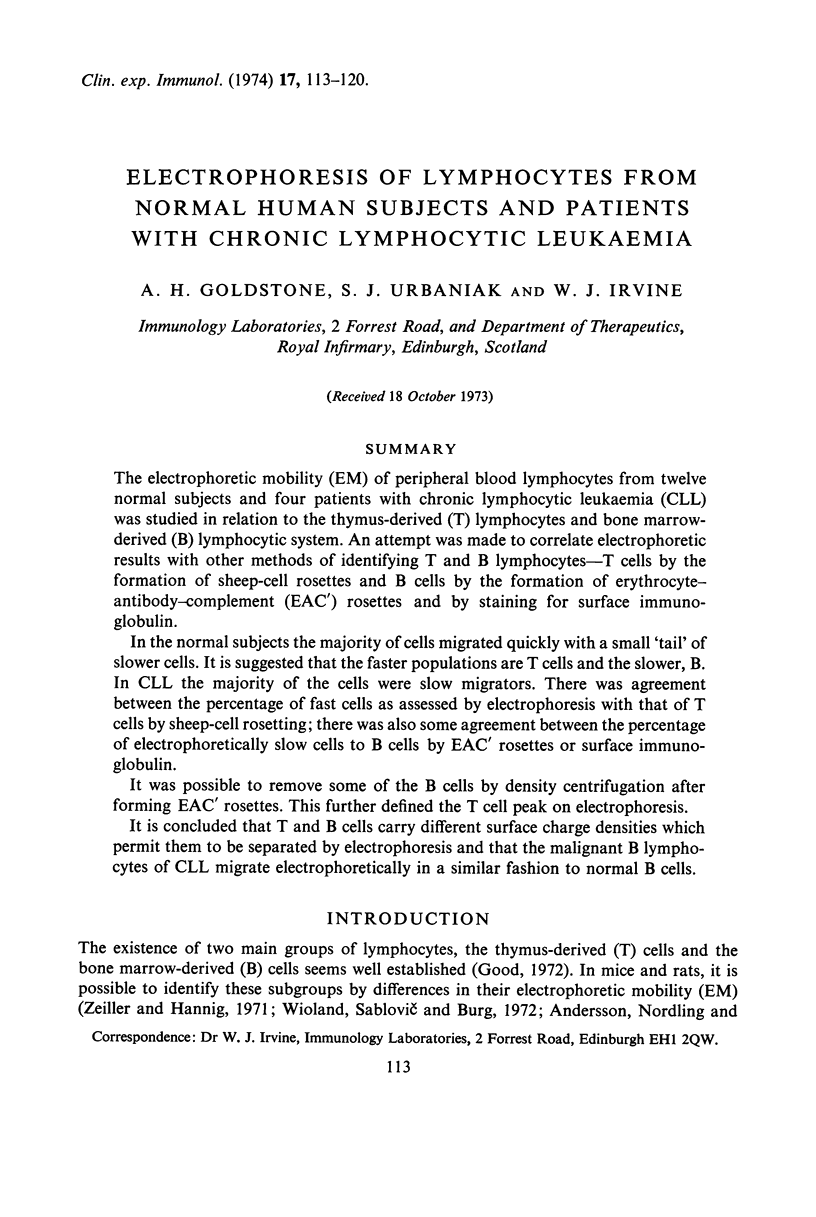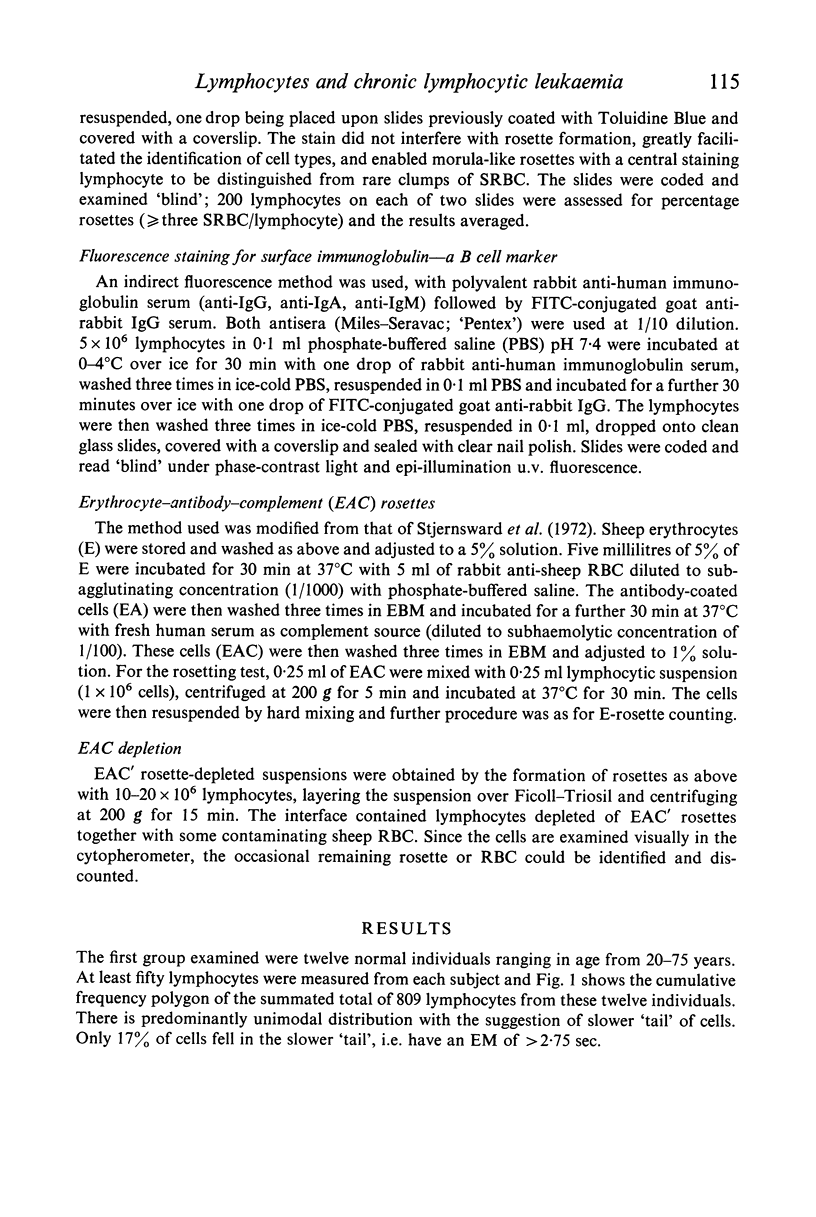Abstract
The electrophoretic mobility (EM) of peripheral blood lymphocytes from twelve normal subjects and four patients with chronic lymphocytic leukaemia (CLL) was studied in relation to the thymus-derived (T) lymphocytes and bone marrow-derived (B) lymphocytic system. An attempt was made to correlate electrophoretic results with other methods of identifying T and B lymphocytes—T cells by the formation of sheep-cell rosettes and B cells by the formation of erythrocyte–antibody–complement (EAC') rosettes and by staining for surface immunoglobulin.
In the normal subjects the majority of cells migrated quickly with a small `tail' of slower cells. It is suggested that the faster populations are T cells and the slower, B. In CLL the majority of the cells were slow migrators. There was agreement between the percentage of fast cells as assessed by electrophoresis with that of T cells by sheep-cell rosetting; there was also some agreement between the percentage of electrophoretically slow cells to B cells by EAC' rosettes or surface immunoglobulin.
It was possible to remove some of the B cells by density centrifugation after forming EAC' rosettes. This further defined the T cell peak on electrophoresis.
It is concluded that T and B cells carry different surface charge densities which permit them to be separated by electrophoresis and that the malignant B lymphocytes of CLL migrate electrophoretically in a similar fashion to normal B cells.
Full text
PDF







Selected References
These references are in PubMed. This may not be the complete list of references from this article.
- Aisenberg A. C., Bloch K. J. Immunoglobulins on the surface of neoplastic lymphocytes. N Engl J Med. 1972 Aug 10;287(6):272–276. doi: 10.1056/NEJM197208102870603. [DOI] [PubMed] [Google Scholar]
- Andersson L. C., Nordling S., Häyry P. Fractionation of mouse T and B lymphocytes by preparative cell electrophoresis. Efficiency of the method. Cell Immunol. 1973 Aug;8(2):235–248. doi: 10.1016/0008-8749(73)90113-5. [DOI] [PubMed] [Google Scholar]
- Currie G. A. Effect of phytohaemagglutinin on the surface charge of human and murine lymphocytes. Nature. 1967 Nov 18;216(5116):694–695. doi: 10.1038/216694a0. [DOI] [PubMed] [Google Scholar]
- Good R. A. Recent studies on the immunodeficiencies of man. Am J Pathol. 1972 Dec;69(3):484–490. [PMC free article] [PubMed] [Google Scholar]
- Jondal M., Holm G., Wigzell H. Surface markers on human T and B lymphocytes. I. A large population of lymphocytes forming nonimmune rosettes with sheep red blood cells. J Exp Med. 1972 Aug 1;136(2):207–215. doi: 10.1084/jem.136.2.207. [DOI] [PMC free article] [PubMed] [Google Scholar]
- Pincus S., Bianco C., Nussenzweig V. Increased proportion of complement-receptor lymphocytes in the peripheral blood of patients with chronic lymphocytic leukemia. Blood. 1972 Sep;40(3):303–310. [PubMed] [Google Scholar]
- Sabolović D., Sabolovic N., Dumont F. Identification of T and B cells in mouse and man. Lancet. 1972 Oct 28;2(7783):927–927. doi: 10.1016/s0140-6736(72)92567-6. [DOI] [PubMed] [Google Scholar]
- Shevach E. M., Herberman R., Frank M. M., Green I. Receptors for complement and immunoglobulin on human leukemic cells and human lymphoblastoid cell lines. J Clin Invest. 1972 Aug;51(8):1933–1938. doi: 10.1172/JCI106999. [DOI] [PMC free article] [PubMed] [Google Scholar]
- Stjernswärd J., Jondal M., Vánky F., Wigzell H., Sealy R. Lymphopenia and change in distribution of human B and T lymphocytes in peripheral blood induced by irradiation for mammary carcinoma. Lancet. 1972 Jun 24;1(7765):1352–1356. doi: 10.1016/s0140-6736(72)91091-4. [DOI] [PubMed] [Google Scholar]
- Streiff F., Stoltz J. F., Genetet B., Humbert J. C., Larcan A. Mobilité électrophorétique des lymphocytes humains en présence d'anticorps cytotoxiques. C R Seances Soc Biol Fil. 1970;164(6):1363–1366. [PubMed] [Google Scholar]
- Wiig J. N. Electrophoresis of lymphoid cells. Characterization of T- and B-lymphocytes and two populations of thymocytes in the mouse. Acta Pathol Microbiol Scand Suppl. 1973;236:101–111. [PubMed] [Google Scholar]
- Wiig J. N., Thunold S. Electrophoresis of lymphoid cells. Characterization of human B and T cells in peripheral lymphoid tissues. Clin Exp Immunol. 1973 Dec;15(4):497–506. [PMC free article] [PubMed] [Google Scholar]
- Wioland M., Sabolovic D., Burg C. Electrophoretic mobilities of T and B cells. Nat New Biol. 1972 Jun 28;237(78):274–276. doi: 10.1038/newbio237274a0. [DOI] [PubMed] [Google Scholar]
- Zeiller K., Hannig K. Free-flow electrophoretic separation of lymphocytes. Evidence for specific organ distributions of lymphoid cells. Hoppe Seylers Z Physiol Chem. 1971 Aug;352(8):1162–1167. doi: 10.1515/bchm2.1971.352.2.1162. [DOI] [PubMed] [Google Scholar]


